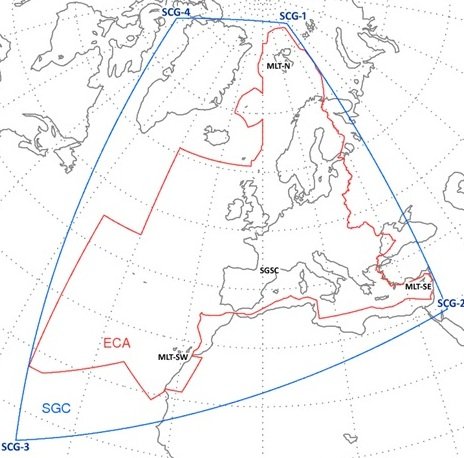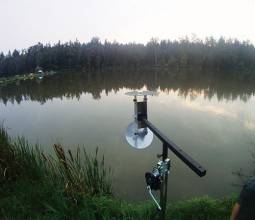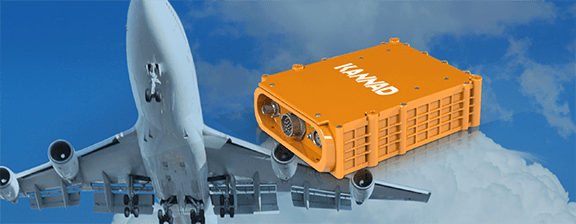 Cospas–Sarsat’s extension to MEOSAR (Medium Earth Orbit Search and Rescue) will extend its search and rescue coverage (the area outlined in red). On the ground the Galileo programme is contributing a Toulouse-based test bench, and a networked trio of MEOSAR ground stations – known as Local User Terminals (LUTs) – to cover Europe, based in Svalbard in the Norwegian Arctic, Cyprus and the Canary Islands. Existing LUTs are distributed on a per country basis, but it is an advantage of MEOSAR that fewer ground stations will be needed for greater coverage. Cospas-Sarsat illustration
Cospas–Sarsat’s extension to MEOSAR (Medium Earth Orbit Search and Rescue) will extend its search and rescue coverage (the area outlined in red). On the ground the Galileo programme is contributing a Toulouse-based test bench, and a networked trio of MEOSAR ground stations – known as Local User Terminals (LUTs) – to cover Europe, based in Svalbard in the Norwegian Arctic, Cyprus and the Canary Islands. Existing LUTs are distributed on a per country basis, but it is an advantage of MEOSAR that fewer ground stations will be needed for greater coverage. Cospas-Sarsat illustration The European Space Agency (ESA) has announced completion of tests that indicate the readiness of the European component of a modernized, GNSS satellite–aided search and rescue service known as Cospas-Sarsat.
ESA has completed construction and testing of a trio of located on three islands at the far corners of the continent, ready to pick up distress calls via satellite from across Europe and its surrounding waters.
The European Space Agency (ESA) has announced completion of tests that indicate the readiness of the European component of a modernized, GNSS satellite–aided search and rescue service known as Cospas-Sarsat.
ESA has completed construction and testing of a trio of located on three islands at the far corners of the continent, ready to pick up distress calls via satellite from across Europe and its surrounding waters.
Founded by Canada, France, the USSR, and the United States, Cospas–Sarsat is a global satellite system for rapidly detecting distress calls to be forwarded to local search and rescue authorities. Since its creation in 1979, it has helped to rescue more than 35,000 people.
Cospas–Sarsat distress beacons can be bought off the shelf, then activated by anyone in distress on land, in the air, or at sea. The beacons emit UHF bursts every 50 seconds. Satellite repeaters pick up and amplify the beacon signals, then transmit them down to ground stations.
Ground stations identify the approximate location of the signal and then pass the information to the rescue authorities. The stations are required to detect and locate all signals received to within five kilometers after 10 minutes.
Up until now, Cospas–Sarsat has relied on satellites in low and high Earth orbits (LEOS and GEOS), but the modernized system will replace the LEOs with middle Earth orbiting (MEO) GNSS satellites. An article in the forthcoming November-December issue of Inside GNSS will describe the improvements in the MEOSAT initiative for Cospas-Sarsat.
The stations sit on Spitsbergen in the Norwegian Arctic, Maspalomas on the largest island of Spain’s Canary Islands, and Larnaca on the island nation of Cyprus, forming a triangle enclosing Europe. The three are coordinated and overseen from a control center in Toulouse, France.
Each site is equipped with four antennas to detect distress calls relayed via satellites in medium-altitude orbits, which will initially include 14 GPS satellites, two European Galileo satellites, and one Russian GLONASS spacecraft.
The three stations are interlinked to operate jointly, so that all 12 antennas can track satellites together. A summer of testing has confirmed the heightened efficiency of this approach.
“This new search and rescue infrastructure, designed by ESA and financed by the [European Union] as part of Galileo, is our contribution to the Cospas–Sarsat system, the world’s oldest and largest satellite-aided rescue system,” explains ESA’s Fermin Alvarez Lopez.
“Medium orbits with satellites such as Galileo are better [than LEOs],” Alvarez Lopez added. “They combine a wide field of view with strong Doppler shift, making it more likely a distress signal is pinpointed promptly and accurately.”
The broad coverage also means fewer ground stations are required — hence, just three can handle the entire European service area. Galileo engineers have introduced another innovation: for the first time those in distress will receive a reply, letting them know their signal was picked up and help is on the way.
Once the stations were completed, testing began, says Igor Stojkovic, ESA’s search and rescue engineer. “We have been demonstrating the system performs as required, ahead of handing it over to its operator, part of France’s CNES space agency, in December.” The new MEOSAT service will begin in 2016.



